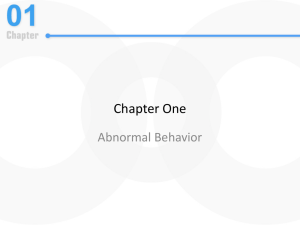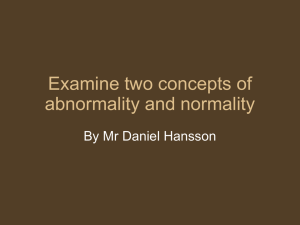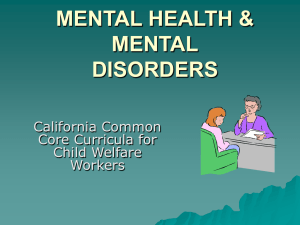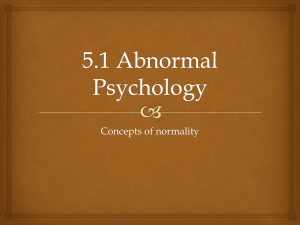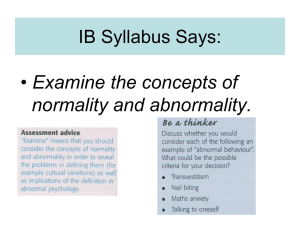a PowerPoint Presentation of Chapter One
advertisement
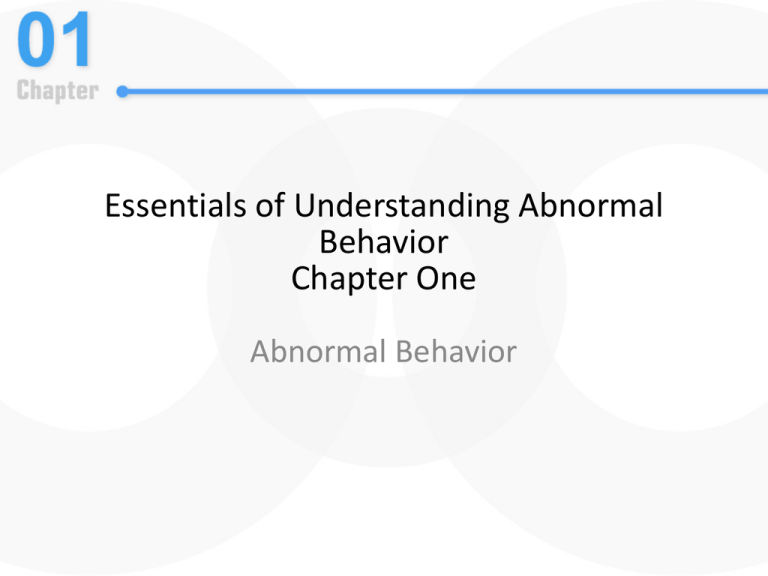
Essentials of Understanding Abnormal Behavior Chapter One Abnormal Behavior The Concerns of Abnormal Psychology • What is abnormal psychology? – An area of scientific study aimed at describing, explaining, predicting, and modifying behaviors that are considered unusual or strange – Uses psychodiagnosis: attempts to describe, assess, and systematically draw inferences about an individual’s psychological disorder The Concerns of Abnormal Psychology (cont’d.) • Modifying abnormal behavior – Therapy: program of systematic intervention aimed at improving a person’s behavioral, affective (emotional), or cognitive state Determining Abnormality • Psychologists use the Diagnostic and Statistical Manual of Mental Disorders (DSM) – Most widely used classification system of mental disorders – Currently in its 5th Version – DSM V (May 2013) – Defines abnormal behavior as: “a behavioral or psychological syndrome or pattern that reflects an underlying psychobiological dysfunction, is associated with distress or disability, and is not merely an expectable response to common stressors or losses.” (www.dsm5.org) Determining Abnormality (cont’d.) • Limitations of DSM-V definition – DSM definition is quite broad and raises questions • When is a syndrome or pattern of behavior significant enough to have meaning? • Is it possible to have a mental disorder without any signs of distress or discomfort? • What criteria are to be used in assessing symptoms? Determining Abnormality (cont’d.) • Four major factors in judging psychopathology – Distress – Deviance (bizarreness) – Dysfunction (inefficiency in behavioral, affective, or cognitive domains) – Dangerousness Cultural Considerations in Abnormality • Culture: – Shared values, beliefs, attitudes and behaviors transmitted from generation to generation – Powerful determinant of how behavior is defined and treated • Multicultural limitations: – How does culture affect our understanding of human behavior? Cultural Considerations in Abnormality (cont’d.) • Cultural universality: – Assumption that origins, processes, and manifestations of mental disorders are the same across cultures • Cultural relativism: – Belief that lifestyles, cultural values, and worldviews affect expression and determination of abnormal behavior Sociopolitical Considerations in Abnormality • Mental illness as a sociopolitical construction – Thomas Szasz: • “Problems in living” versus “mental illness” – Must be sensitive to individual value systems, societal norms and values, and potential sociopolitical ramifications The Frequency and Burden of Mental Disorders • Psychiatric epidemiology: – Study of the prevalence of mental illness in a society • Prevalence: – Percentage of individuals in a targeted population who have a particular disorder during a specific period of time The Frequency and Burden of Mental Disorders (cont’d.) • Incidence: – Number of new cases of a disorder that appear in an identified population within a specified time period • Lifetime prevalence: – The percentage of people in the population who have had a disorder at some point in their life The Frequency and Burden of Mental Disorders (cont’d.) Figure 1-1 1-year prevalence of mental disorders in adult Americans and lifetime prevalence of mental disorders in American adolescents Stereotypes about People Who are Mentally Disturbed • Americans tend to be suspicious of people with mental disorders • Common myths: – People who are mentally disturbed can always be recognized by their abnormal behavior – People who are mentally disturbed have inherited their disorders Stereotypes (myths) about the Mentally Disturbed (cont’d.) • Mental illness is incurable; Nearly three-fourths of people who are hospitalized with severe mental disorders will improve and go on to lead productive lives. • People become mentally disturbed because they are weak willed • Mental illness is always a deficit; Many people with mental illness were never “cured,” but they nevertheless made great contributions to humanity. • Mentally disturbed people are unstable and potentially dangerous Historical Perspectives on Abnormal Behavior • Prehistoric and ancient beliefs: – Demonology treated by trephining or exorcism • Naturalistic explanations (Greco-Roman): – Naturalistic explanations supplanted supernatural – Hippocrates believed deviant behavior was caused by brain pathology, dysfunction or disease of the brain Historical Perspectives on Abnormal Behavior (cont’d.) • Mass Madness (13th century): Group of people exhibit similar symptoms with no apparent cause. – Tarantism: wild dancing and convulsions assumed to be caused by spider’s bite – Lycanthropy: imitating wolves and imagining themselves as wolves • Witchcraft (15th-17th centuries): – The Hammer of Witches: (1484) Pope Innocent VIII approved the persecution of witches. Two priests, Heinrich Kramer and James Sprenger wrote “Malleus Maleficarum” Historical Perspectives on Abnormal Behavior (cont’d.) • The Reform Movement: • Philippe Pinel: began the moral treatment movement, treated patients with kindness and reason – rather than chains and torture. • William Tuke: created the York retreat, also subscribing to the moral treatment movement. • Benjamin Rush (1745-1813): considered the father of US psychiatry, trained physicians to treat patients with mental disorders and to practice humane treatment. • Dorothea Dix (1802-1887): Spent 40 years working for humane treatment of the mentally ill and raised millions of dollars. • Clifford Beers (1876-1943): wrote A Mind that Found Itself about his own battle with mental illness and the treatment he and others experienced in 3 mental institutions. Causes: Early Viewpoints • Biological (organic) view: – Belief that mental disorders have a physical or physiological basis (Griesinger) – Kraepelin • Symptoms occur in clusters (syndromes) to represent mental disorders, each with unique cause, course, and outcome • Classified mental illness based on organic causes • Original basis for Diagnostic Statistical Manual of American Psychiatric Association Causes: Early Viewpoints (cont’d.) • Biological view gained greater strength with discovery of general paresis, a progressively degenerative and irreversible physical and mental disorder related to late-stage syphallis – Fritz Schaudinn (1905) discovered the micororganism that actually causes syphilis and the resulting neurological deterioration, the first definite evidence for medical cause in psych. disorder was discovered. Causes: Early Viewpoints (cont’d.) • Psychological view: – Mental disorders are caused by psychological and emotional (not biological/organic) factors • Mesmerism and hypnotism: – Josef Breuer: • Relief by talking about traumatic experiences • Cathartic method: therapeutic use of verbal expression to release pent-up emotional conflicts – Sigmund Freud: psychoanalysis Contemporary Trends • Multicultural psychology: – Culture, race, ethnicity, gender, age, and socioeconomic class relevant to understand and treat abnormal behavior – Mental health professionals need to: • Increase cultural sensitivity • Acquire knowledge of diversity • Develop culturally relevant therapy approaches Contemporary Trends (cont’d.) Figure 1-2 Census 2010 Racial and Ethnic Composition of the United States The rapid demographic transformation of the United States is illustrated by the fact that minorities now constitute an increasing proportion of the population. Several trends are evident. First, within several short decades, people of color will constitute a numerical majority. Second, the number of Latino/Hispanic Americans has surpassed the number of African Americans. Third, mental health providers will increasingly be coming into contact with clients who differ from them in race, ethnicity, and culture. Source: http//www.census.gov/newsroom/release/ archives/2010_census/cb11-cn125htm Contemporary Trends (cont’d.) • Dimensions related to cultural diversity: – Social conditioning: How we are raised, what values are instilled in us, and how we are expected to behave in fulfilling our roles – Cultural values and influences: types of mental disorders differ from country to country and differences in cultural traditions may influence susceptibility to certain emotional disorders. – Sociopolitical influences: In response to a history of prejudice, discrimination, and racism, many minorities adopted behaviors important for their survival – Cultural and ethnic bias in diagnosis: Mental health professionals are not immune to inheriting the prejudicial attitudes Contemporary Trends (cont’d.) • Positive psychology: – Study of positive human functioning, and the strengths and assets of individuals, families, and communities • Focuses on strengths and assets of people in preventing psychological disorders Contemporary Trends (cont’d.) – The drug revolution (1950s): • Rapidly and dramatically decreased or eliminated troublesome symptoms • the drug chlorpromazine (brand name Thorazine) was extremely effective in treating agitated people with schizophrenia • Deinstitutionalization – Prescription privileges for psychologists – Managed health care: • Industrialization of health care, whereby large organizations in the private sector control the delivery of services Contemporary Trends (cont’d.) • Industrialization of health care has brought about major trends: – Business interests are exerting increasing control over psychotherapy – Current business practices are depressing income of practitioners – Psychologists are being asked to justify use of their therapies – Enactment of mental health and substance abuse parity legislation Contemporary Trends (cont’d.) • Appreciation for research – Breakthroughs in neuroscience • Role of neurotransmitters in mental disorders – Renewed interest in brain-behavior relationship with success of psychopharmacology – Increasing exploration of biological bases of abnormal behavior – Integration of drug therapy with psychotherapy – Move toward empirically-based treatments
